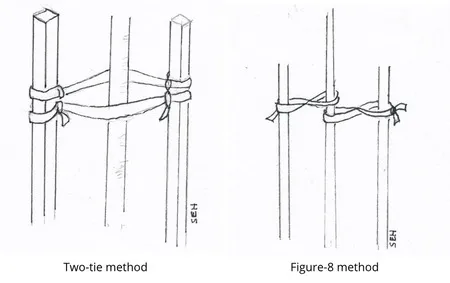Sometimes we get questions about leaning trees. People want to know if a tree that is leaning can be straightened out, and how. This is what we’ve learned.
The first question to consider is why is the tree leaning? For most young trees, with trunks smaller than 4” in diameter, the leaning can be traced back to one of a few issues:
• One possibility is that the roots have only grown on one side of the tree, causing the tree to be less firmly anchored in the ground on the opposite side. When the tree was planted, were the roots fanned out across the planting hole, or was the tree put directly from the container into a smaller hole? If the roots end up growing only in one direction, the tree will not be supported against forces pushing in other directions.
• Similarly, a large landscape plant, fence, or other structure may be blocking some sunlight, causing the tree to produce more growth on the sunny side.
• Leaving the nursery stake attached to the tree too long is another very common cause of leaning trees. Trees need to be able to move in response to wind to be able to develop a strong trunk.
• Finally, there are instances where a multi-grafted fruit tree may have some grafts that grow more vigorously, dominating tree growth and causing the tree to be heavier on one side.
With a young tree, if you suspect the roots have grown unevenly, check to see whether the root ball is stable in the ground or whether it moves when you gently wiggle the tree. You might be able to push it back a bit toward vertical but be careful not to damage the roots or the wood. You can try staking to prevent any further lean, but do not tie the tree up so tightly as to prevent movement. For structural strength the tree needs to be able to move in the wind. Also use soft ties to prevent damage to the bark. Do not have the stake or stakes against the tree, but out several feet. This staking should not be left in place longer than one year.
The following images illustrate two ways of staking your tree:

Pruning is another option, especially for trees that have grown unevenly due to grafting or blocked sun. For older trees, especially, pruning may offer an alternative if you aren’t able to physically straighten the tree. Your tree already has a strike against it because the leaning trunk can make it more prone to falling. Keeping the tree canopy smaller will not only keep it easier to care for but will also help to make the tree less likely to fall due to inclement weather.
Be careful as you think about pruning that you don’t create a situation where the tree is unbalanced. This is an important concern when pruning any tree, but more so in the case of a tree where the trunk is leaning. Walking around the tree and looking from all angles will help you to decide the answer to this question. You might also want to consult a trained arborist.
One final note — larger trees that are leaning may become “hazard” trees. These are trees that are likely to cause damage or injury if they fall. These trees should be removed. If a large tree is leaning but isn’t a hazard, another possibility is to use guy wires to support it. Such a solution is best left to professionals.
For more information on working with leaning trees you might find these articles helpful.
• Myths about Staking Trees: https://ucanr.edu/blog/topics-subtropics/article/tree-staking-myths
• Staking and guying trees: https://extension.umn.edu/planting-and-growing-guides/staking-and-guying-trees
• Staking trees: https://ipm.ucanr.edu/PMG/GARDEN/PLANTS/CULTURAL/staking.html
• What to do About Leaning Trees: https://extension.psu.edu/what-to-do-about-leaning-trees
• The Planting and Care of Young Trees: https://anrcatalog.ucanr.edu/pdf/8048.pdf
• How to find a certified arborist: https://wwv.isa-arbor.com/membership/benefitstools/findtcs
Help Desk of the UC Master Gardeners of Contra Costa County (RDH)

